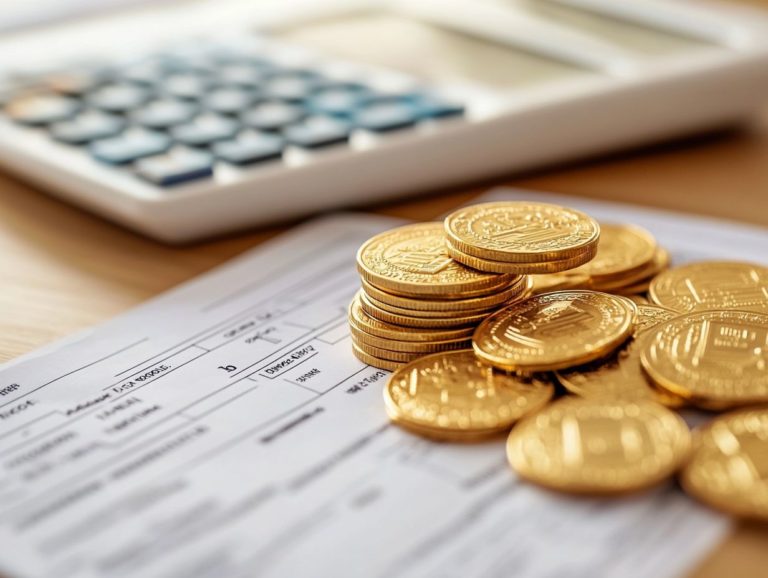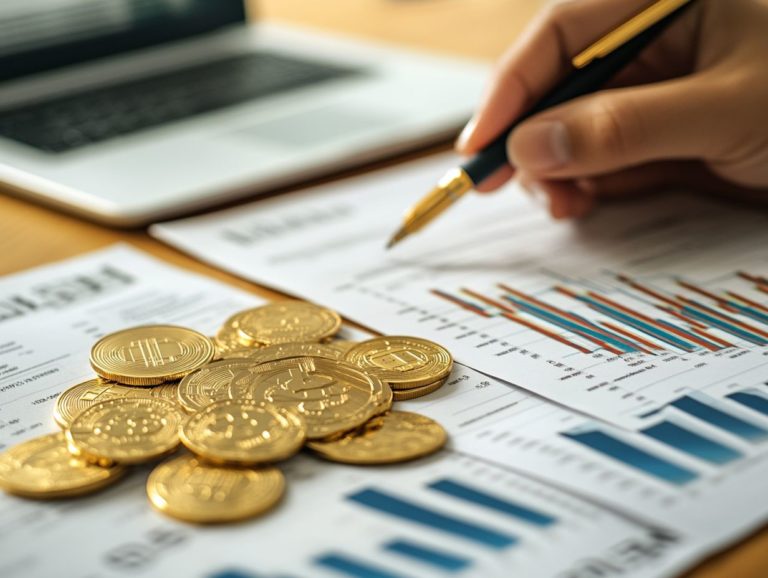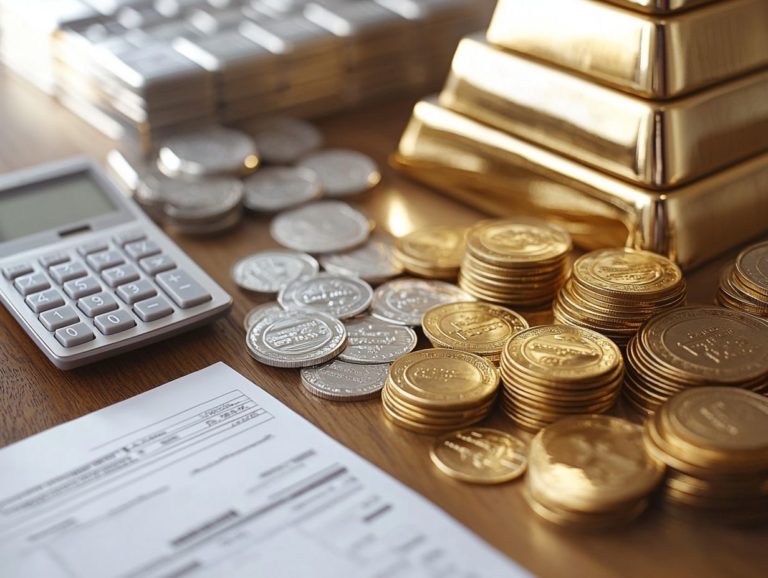Understanding the Tax Effects of Precious Metals Trading
Precious metals have long captured the attention of investors. They offer stability and serve as a safeguard against economic turbulence.
As the appeal of trading gold, silver, and platinum rises, it s crucial to understand the tax implications. This article covers what qualifies as precious metals and highlights the benefits of trading them.
We ll outline essential tax considerations, including capital gains tax and your reporting responsibilities. You’ll also discover effective strategies for minimizing tax liabilities.
Gain insights into risk management and market trends. Knowing the legal aspects is vital for every trader.
Whether you’re a seasoned investor or just starting, understanding these elements empowers you. It helps you navigate the precious metals market with confidence.
Contents
Key Takeaways:
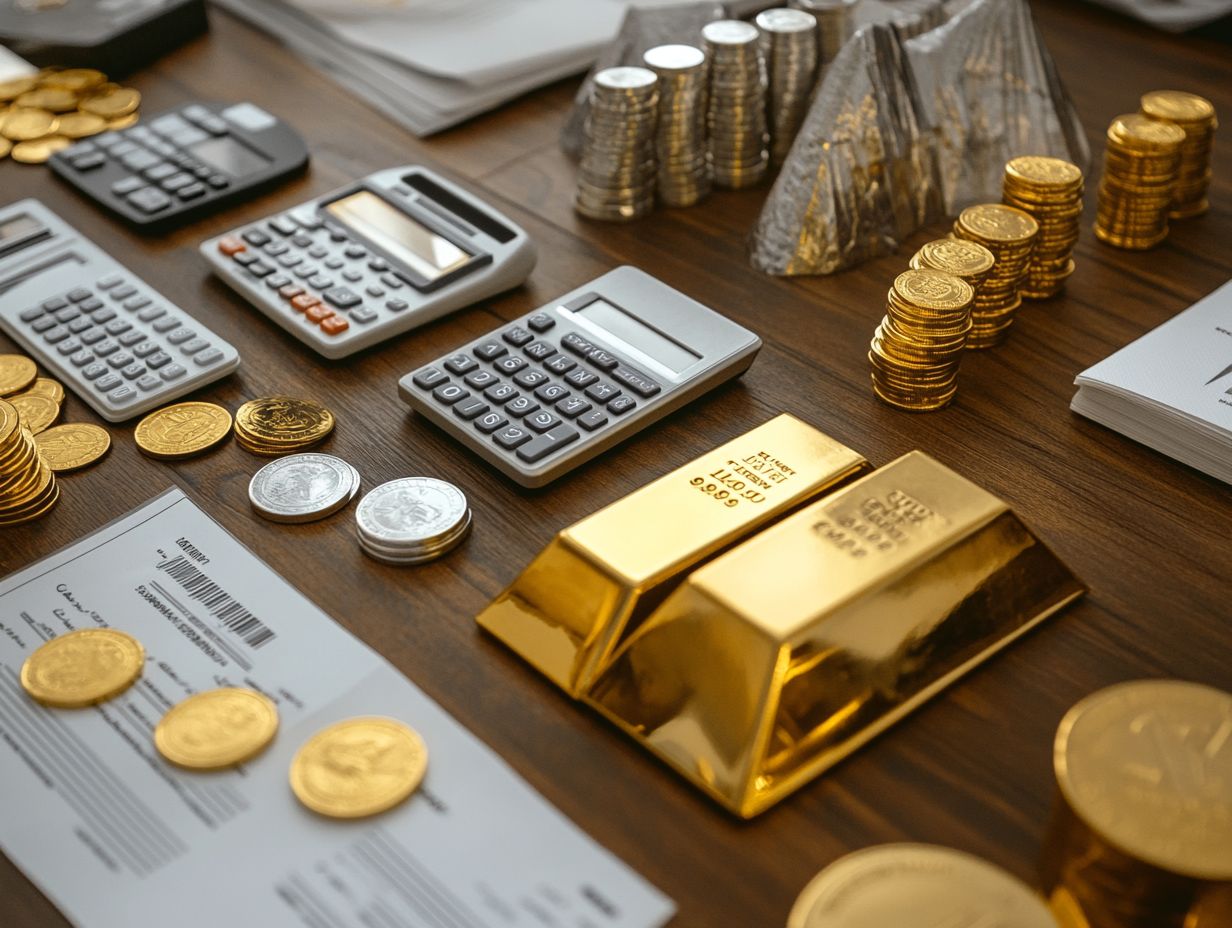
- Understand the tax implications of trading precious metals, including capital gains taxes and reporting requirements.
- Minimize tax liabilities by employing smart strategies such as selling losses to offset gains and utilizing retirement accounts.
- Consider risk management, market trends, and legal factors when trading in precious metals.
What are Precious Metals?
Precious metals, such as gold, silver, and platinum, are naturally occurring metallic elements that hold immense value due to their rarity and economic stability. This makes them vital capital assets in your diversified investment portfolio.
Gold and silver have unique qualities that make them attractive. They are sought after for industrial applications and act as a hedge against inflation and economic uncertainty.
During times of market volatility, many investors gravitate toward precious metals as a safe haven. Physical gold and silver serve as tangible assets that can bolster financial growth and mitigate the risks associated with equity investments.
These assets come with unique characteristics, such as resistance to corrosion and excellent conductivity. This makes them valuable across various sectors from electronics to jewelry fabrication.
Gold, often regarded as the king of precious metals, is especially favored for its liquidity and historical role as a form of currency. Silver, with its dual function as both an industrial metal and a store of value, draws in numerous investors seeking diversification.
Meanwhile, platinum, rarer than both gold and silver, offers properties that provide both prestige and high demand in automotive catalytic converters. This multifaceted appeal highlights why many investors consider incorporating precious metals into their strategies for a balanced portfolio.
Why Trade Precious Metals?
Investors love trading precious metals. It has emerged as a favored practice among savvy investors seeking to diversify their portfolios and hedge against economic uncertainty.
With the stock market’s unpredictable nature, you may find yourself exploring alternative routes to safeguard your capital gains and shield against potential losses.
This strategy mitigates the risks tied to stock market investments. It also enhances the overall stability of your portfolio.
As inflation climbs and currency values shift, the intrinsic value of these metals typically rises. This reinforces their status as reliable financial assets.
By incorporating precious metals, you can fine-tune the risk-reward ratio of your investment portfolio. Even during turbulent times, you maintain a sense of growth and security.
By grasping market trends and leveraging these assets wisely, you can navigate economic downturns with increased confidence and poise.
Start exploring your options in precious metals today! There s no better time than now!
Tax Implications of Precious Metals Trading
Understanding the tax implications of precious metals trading is crucial for maximizing your returns and staying compliant with IRS regulations. Trading precious metals whether through physical assets or investment vehicles like gold ETFs and mining stocks creates various tax liabilities based on capital gains tax rates that differ for short-term and long-term gains.
You will also need to manage reporting requirements for these trades. Completing Form 1099-B is essential for determining your taxable income and how profits and losses are taxed.
Capital Gains Tax
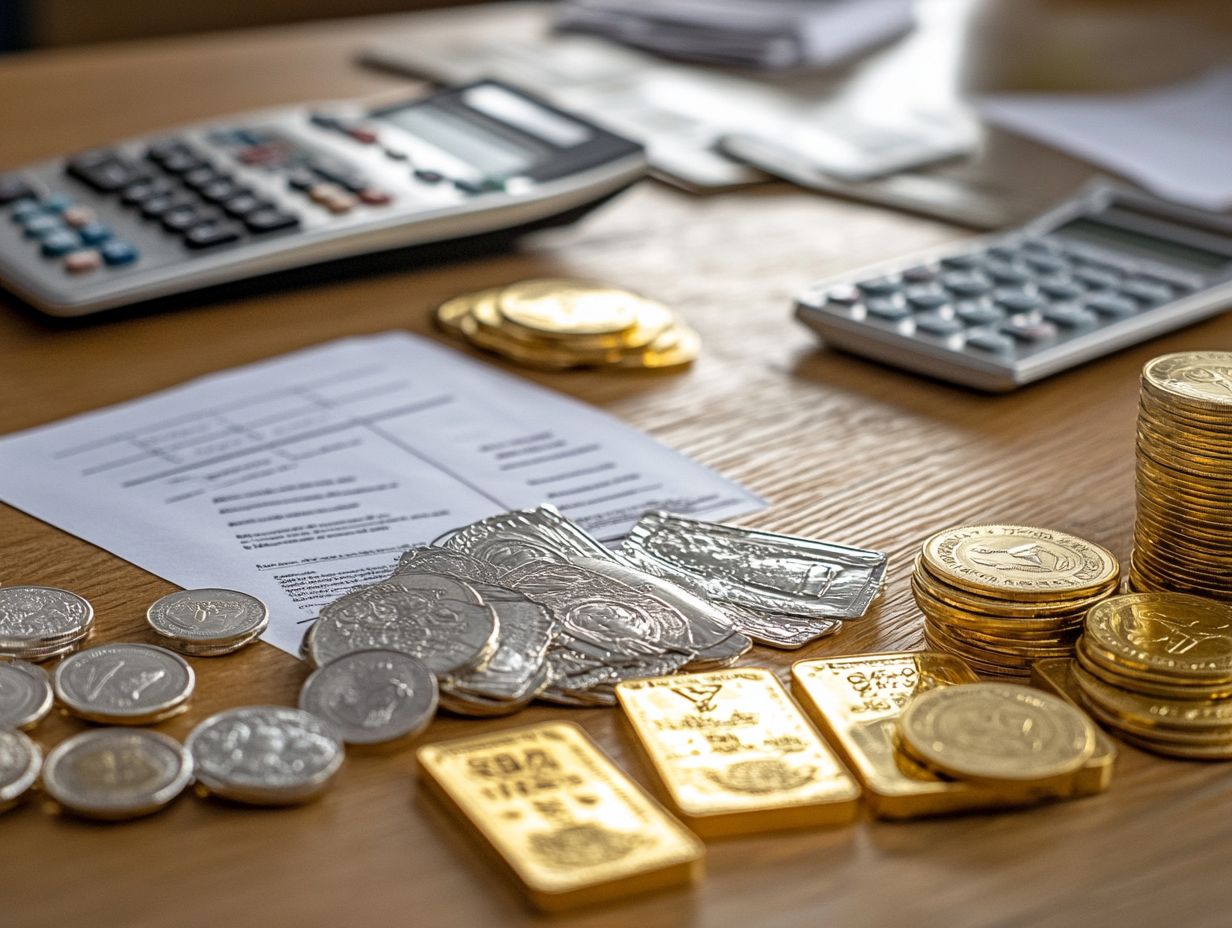
Capital gains tax is a key factor when trading precious metals. It affects the taxes on profits from selling assets.
The IRS taxes short-term gains, typically from assets held for one year or less, at ordinary income rates. This can significantly raise your tax bill.
In contrast, long-term gains applicable to assets held for over a year are taxed at lower rates, allowing you to keep more of your profits.
Different precious metals like gold, silver, and platinum may have unique tax treatment. To minimize your tax exposure, consider using tax-deferred accounts or timing your sales to benefit from lower long-term rates.
Reporting Requirements
Understanding the reporting requirements for trading precious metals is crucial for tax compliance. You must accurately report your transactions on Form 1099-B, which details gains and losses from sales of precious metals.
Neglecting these could increase your tax liability and draw unwanted attention from tax professionals. Therefore, keeping detailed records of your investment activities is essential.
Besides Form 1099-B, be aware of other documents, like the Bank Secrecy Act requirements for high-value transactions. Keeping thorough records protects you from audits and helps with accurate tax filings. It’s wise to keep transaction records for at least three years, or longer if you trade extensively.
Non-compliance can lead to hefty financial penalties, making it critical to follow best practices in precious metals trading.
Tax Strategies for Precious Metals Trading
Implementing effective tax strategies is vital for investors in precious metals trading. This approach minimizes tax liability and enhances overall investment returns.
Utilizing IRAs or Gold ETFs can provide significant tax advantages, allowing you to defer taxes on capital gains. Understanding how different investment types, including collectible assets, are taxed can help align your strategies with your tax objectives.
Minimizing Tax Liability
Minimizing your tax liability is crucial in precious metals trading. It can significantly influence your overall investment goals and financial growth.
By utilizing ways to invest that save you taxes and strategies, you can effectively reduce your taxable income and enhance your long-term returns.
Collaborating with a tax professional can provide you with tailored advice on navigating the complexities of taxes associated with trading precious metals.
This proactive approach might include leveraging tax-deferred accounts, like IRAs, which offer considerable tax advantages. You might also consider selling losing investments to reduce your taxes to offset gains.
Understanding capital gains tax rates this is the tax on the profit from selling an asset and the holding period for different types of assets is pivotal in shaping your overall tax strategy.
Keep an eye on changing tax laws to spot new opportunities or risks that could affect your trading. A well-rounded strategy that combines prudent investment choices with expert guidance on tax implications is essential for achieving optimal tax efficiency.
Other Considerations for Precious Metals Traders
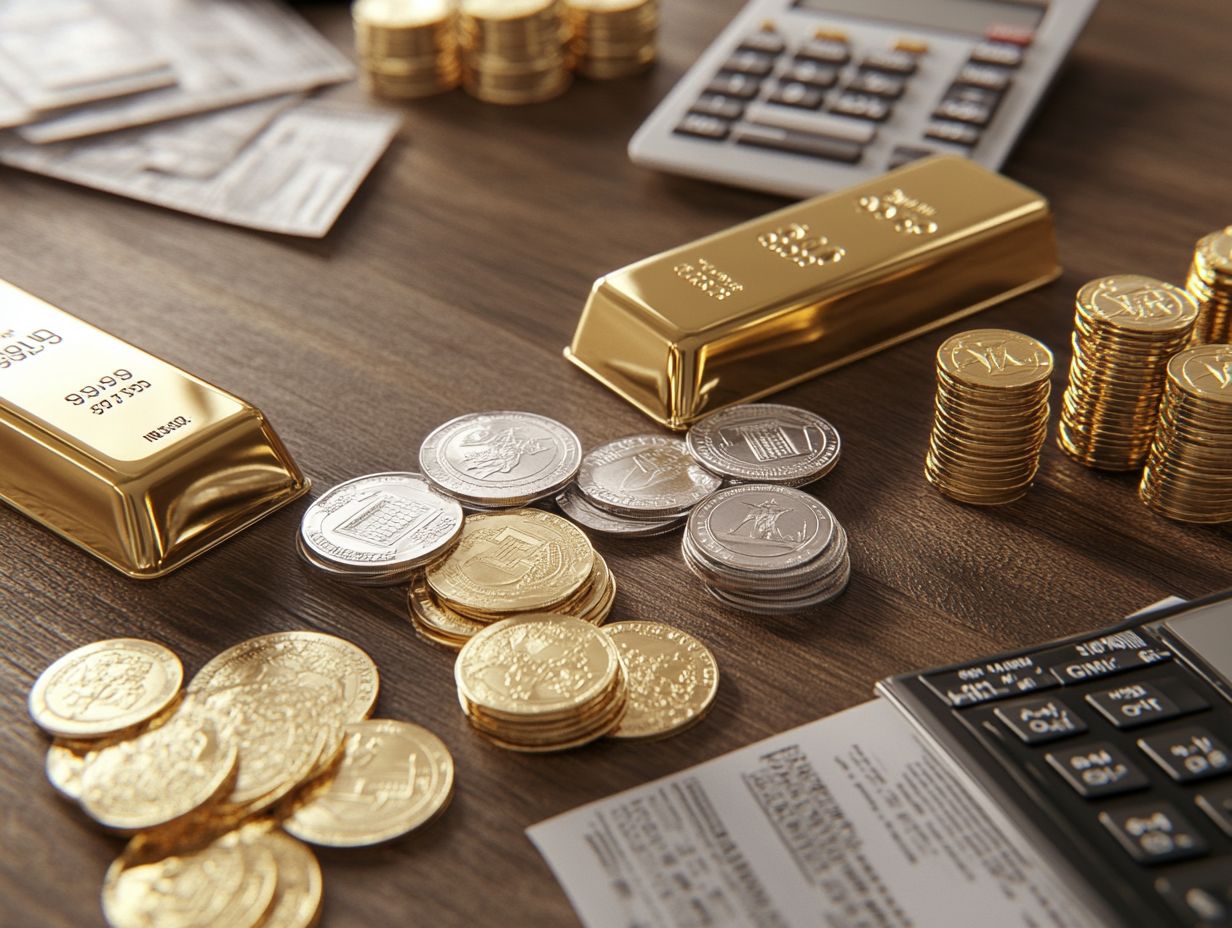
Beyond tax implications, there are many factors to consider as a precious metals trader. These can significantly influence your investment decisions and outcomes.
Grasping market trends and conducting meticulous analyses are essential steps in pinpointing profitable trading opportunities.
Don’t forget to consider the legal and regulatory aspects that can affect your trading practices.
Employing effective risk management strategies like setting stop-loss orders and maintaining a diversified portfolio is crucial for navigating the unpredictable nature of the precious metals market.
Risk Management
Effective risk management is essential for you as a precious metals trader. It allows you to mitigate potential losses while maximizing returns in a market that often dances to a volatile rhythm.
Incorporating strategies like portfolio diversification is key. Consider mixing various precious metals with other asset classes to minimize your exposure to market fluctuations.
Make it a habit to check market trends regularly. This can significantly enhance your decision-making process, leading to more successful trading outcomes.
By spreading your investments across different precious metals like gold, silver, platinum, and palladium you create a buffer against the unpredictability of any single commodity.
Integrating other assets, such as stocks, bonds, or real estate, adds even more layers of security to your portfolio.
It’s vital for you to regularly analyze market indicators, geopolitical events, and economic factors that might sway prices.
This awareness fosters better timing and allows for strategic adjustments when needed. By employing these risk management techniques, you can navigate the complexities of the precious metals market with heightened confidence and resilience.
Market Trends and Analysis
Understanding market trends and conducting a comprehensive analysis are essential for you as an investor trading precious metals.
These elements provide valuable insights into price movements and potential trading strategies.
By looking into historical data, geopolitical events, and economic indicators, you can make informed decisions that align with market expectations.
Staying updated on these trends will empower you to capitalize on favorable trading conditions and navigate potential downturns effectively.
Utilizing analytical techniques like technical analysis studying price patterns and volume alongside fundamental analysis, which focuses on intrinsic value, can significantly enhance your decision-making process.
Tools such as charting software and market sentiment indicators will equip you to identify emerging trends. This allows you to act swiftly and decisively.
Understanding factors like supply and demand dynamics or currency fluctuations can further refine your approach. This ultimately fosters a more robust trading strategy tailored to the ever-changing landscape of precious metals.
Legal and Regulatory Factors
Legal and regulatory factors greatly impact your precious metals trading. They influence investor behavior and compliance requirements. By understanding the rules governing the market like sales tax exemptions and state sales tax rules you can navigate the market’s complexities more easily.
Ensuring compliance with laws is crucial to avoid penalties and protect your investments. Stay vigilant about anti-money laundering (AML) laws and the regulations established by organizations like the Financial Crimes Enforcement Network (FinCEN). Staying well-informed about licensing, reporting obligations, and customer identification programs boosts your credibility as a trader and shields you from potential legal repercussions.
By emphasizing due diligence, you position yourself to respond effectively to regulatory changes and manage inherent risks in the industry. A solid understanding of these legal frameworks promotes compliance and fosters a more stable, transparent trading environment.
Frequently Asked Questions
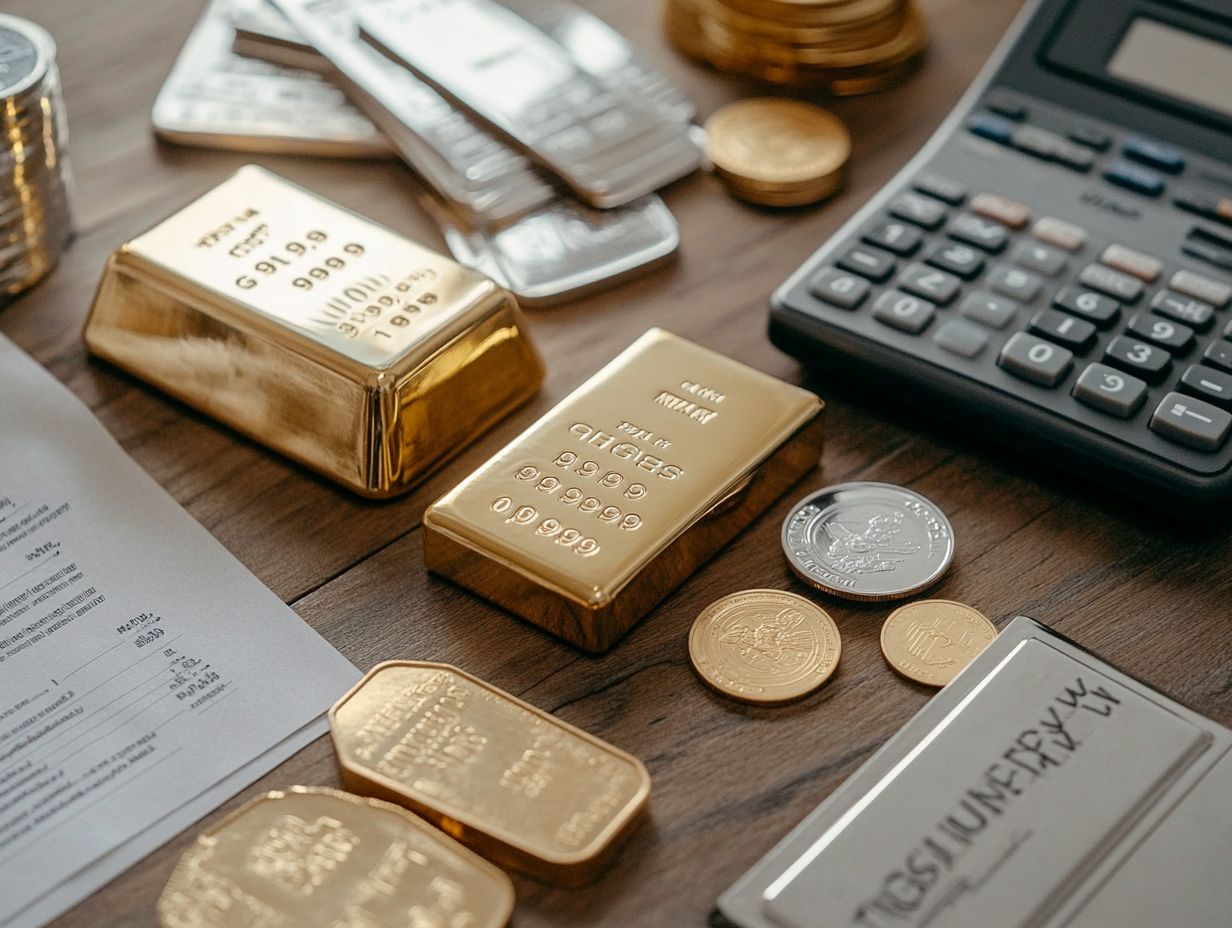
What are the tax implications of trading in precious metals?
The tax effects of trading in precious metals depend on factors such as the type of metal, holding period, and your individual tax situation. Understanding these implications is important for proper tax reporting.
Do I have to pay taxes on gains from precious metals trading?
Yes, gains from trading in precious metals are subject to taxes. They are considered capital gains and taxed at either short-term or long-term rates, depending on how long you held the metal before selling it.
How are taxes on precious metals calculated?
Taxes on precious metals trading are calculated based on the difference between the purchase price and the selling price, also known as the capital gain. Short-term gains are taxed at your ordinary income tax rate, while long-term gains are taxed at a lower rate.
Are there any tax deductions for precious metals trading?
Unfortunately, there are no specific tax deductions for trading in precious metals. However, you may be able to deduct trading expenses, like fees and commissions, as part of your investment costs on your tax return.
Facing losses in precious metals trading? Learn how to utilize them to your advantage!
If you have a net loss from trading in precious metals, you may use it to offset other capital gains in the same tax year. If your losses exceed your gains, you can use up to $3,000 of the excess loss to offset your ordinary income. Any remaining losses can be carried over to future tax years.
Are there any tax reporting requirements for precious metals trading?
Yes, you must report all precious metals trading activity on your tax return, including the purchase and sale of metals. Keeping accurate records of your trading activity is essential to ensure proper reporting and avoid penalties from the IRS.
Stay informed and compliant to protect your investments today!










